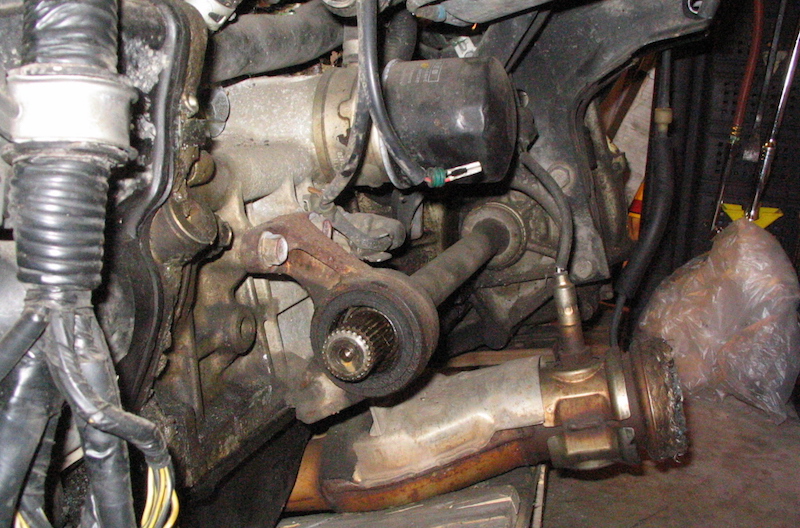An intermittent misfire can be a really maddening problem, and it can be enough to make your vehicle fail an emissions test as well. A P0300 trouble code means that one or more cylinders is misfiring and not completely burning its fuel/air mixture. Bearing in mind that you need the triad of fuel, air, and spark for your engine to run properly, the P0300 code gives a tech a head start on doing the necessary deduction to figure out what's going on.
Note: Code scanning is one of the free services available at your local Advance Auto Parts store.
P0300: Random/Multiple Cylinder Misfire — What It Means
Like we mentioned above, a P0300 code means that there's a problem that's keeping fuel from being burned in at least one cylinder, resulting in a misfire. This code can refer to both a random misfire on one cylinder or misfires on multiple cylinders.
Symptoms
- Poor fuel economy
- Jerking, bucking, rough running
- Strong smell of fuel in exhaust
- Rough idle
- Illuminated Check Engine light (CEL)
- Flashing CEL
What Happens If I Ignore It?
A severe miss is a problem you don't want to ignore. An engine with a misfire can result in ignition damage, internal damage or a failed catalytic converter due to raw gas being dumped into the converter. In fact, a flashing CEL is a direct warning that your converter is in danger of being damaged. A P0300 code needs immediate attention.
Possible Causes
- Failed ignition coil pack
- Worn spark plugs
- Clogged fuel injector
- Loose vacuum hose(s)
- Loose electrical connector(s)
- Problem with a spark plug, fuel injector, or engine ground wire
- Low fuel pressure
- Internal engine problems, i.e. burned valve, broken valve spring, worn valve guide, stretched timing chain
- Defective camshaft position sensor
- Defective crankshaft position sensor
It's always a good idea to start with the simplest and most obvious things (meaning a thorough visual inspection of everything), then work your way through process of elimination. Some clarification is needed, so let's narrow this down a little.
Finding the cause
Spark plug wires are mentioned as a possible cause, but if you have a vehicle that's more recent than the early 00's, your engine will likely have coil packs rather than a distributor, ignition coil and plug wires.
Coil packs are a miniature ignition coil that sits on the spark plug itself and are triggered by the powertrain control module. These coil-on-plug modules are efficient but they do tend to fail after many years and miles of service, so checking coil packs is an excellent first step if the visual inspection doesn't reveal any problems. Like in the old days of plug wires, a good way to diagnose a bad coil pack is to disconnect coil packs one at a time and see if there's any appreciable difference in the way the engine runs. Like with many other components, it's a good idea to replace all coil packs simultaneously.
The next most obvious place to look is the spark plugs. Modern spark plugs can last anywhere from 50k to 100k miles, but they can still end up with electrodes that are so worn and eroded that they can't deliver a good arc anymore. Using a spark plug socket, pull out a plug and get a look at it. A healthy spark plug should be cocoa-colored, and its tip shouldn't be excessively worn. Changing plugs is a fairly easy job on many vehicles, although the rear cylinder bank on a transverse-mounted V6 can be difficult to get to.
In some cases, a P0300 code can even be caused by a tank of watery or poor-quality fuel. An application of fuel treatment or fuel conditioner can be a good idea if you suspect poor fuel.
If the problem is with a camshaft or crankshaft position sensor, you'll also see a code such as P0340, P0339, P0340, P0017, P0336 or other related codes along with the P0300 code.
Tests to pin down the cause
Here are some other tests you can perform when tracking down a misfire:
- Perform a compression test by screwing a compression gauge into each spark plug socket and then cranking the engine. Remember, though, that a cylinder with low compression would cause a very regular and rhythmic misfire, not an irregular stumble or miss.
- A misfire code on two adjacent cylinders can point to a head gasket problem. If that's the case, you're likely to see other trouble codes (P0301, P0302, P0308) as well as indicators like coolant in the motor oil or bubbling through the radiator as combustion gases make their way back into the cooling system — in which case it might be time to see out the help of a professional.
- Perform a fuel pressure test by connecting a pressure gauge to the Schrader valve on the fuel line. Low pressure can cause multiple misfires.
- Using an engine stethoscope or just a long screwdriver pressed against your ear, listen for the ticking sound of each fuel injector opening and closing. Like mentioned above with spark plug wires, you can disconnect the electrical pigtail for each injector one-by-one while the engine idles and listen for any change in idle quality, or check each injector with a multimeter.









